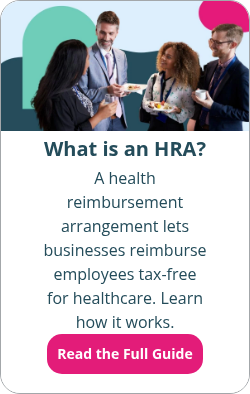What are the ACA essential health benefits?
By Holly Bengfort on February 1, 2024 at 7:55 AM
Before the implementation of the Affordable Care Act (ACA) in 2014, health plans typically had various exemptions for essential services, including maternity care, hospital treatment, and coverage for prescription drugs. But since Congress passed the ACA, all individual and small group medical plans must now offer a set package of services, or essential health benefits (EHBs), for all those enrolled.
While large group plans are exempt from this requirement, typical employer plans cover the EHBs to ensure their employees have the best health coverage. Individual health insurance plans, such as those you can purchase on the Health Insurance Marketplace, are also subject to EHB regulations.
In this article, we'll go over what the EHBs are, why they were created, and how a health reimbursement arrangement (HRA) works under the EHB requirements.
Takeaways from this blog post:
- Essential health benefits (EHBs) are a minimum package of 10 items and services that all plans in the individual and small group market must cover.
- Under federal requirements, EHBs include coverage for ambulatory patient services, emergency services, hospitalization, pregnancy and newborn care, mental health services, prescription drug coverage, rehabilitative services, laboratory services, preventive services, and pediatric services.
- EHBs vary from state to state, but certain regulations are standard across all plans, such as offering dental coverage for children.
What are the 10 essential health benefits?
EHBs are a minimum package of 10 items and services that all plans in the individual and small group market must cover. This includes qualified health plans available on the ACA's health insurance exchange and off-exchange.
Understanding what qualifies as EHBs is important to make the most of your health insurance plan. Even if your plan covers these benefits, your premiums and copays will vary, so take a close look at the details of your plan type and the costs that come with it.
The ACA outlines and requires 10 categories of essential health benefits coverage for all plans:
- Ambulatory patient services. This refers to outpatient services that you can receive without hospital admission.
- Emergency services. You can't be charged more for going to an out-of-network hospital's emergency room if it's a true emergency.
- Hospitalization. Insurance plans must cover inpatient care, including surgeries, overnight stays, and other hospital services.
- Pregnancy, maternity, and newborn care. Insurers must cover medical services for you and your child, both before and after birth, as well as the cost of the delivery, birth control, and breastfeeding services.
- Mental health services and substance use disorder services. This includes coverage for mental health services, such as therapy and counseling, as well as treatment for substance use disorders.
- Prescription drug coverage. Insurance plans must cover a wide range of prescription drugs, including both generic and brand-name medications.
- Rehabilitative services and habilitative services and devices. This is intended to help people with chronic conditions, disabilities, or injuries regain or improve skills.
- Laboratory services. Lab services and tests that doctors might run to aid in a diagnosis.
- Preventive services, wellness services, and chronic disease management. Insurance plans must cover preventive care services, such as vaccinations and screenings, as well as chronic disease management services.
- Pediatric services, including oral and vision care. This includes coverage for pediatric services, such as well-child visits, vaccinations, and dental and vision care for children.
Once you've reached your annual out-of-pocket limit for EHBs, your plan will cover 100% of the cost of the above benefits. With EHBs, the ACA prohibits annual limits or lifetime dollar limits on the amount of money the health insurer will pay for the covered services.
The ACA designed these EHBs to ensure individuals have access to the comprehensive coverage they need for necessary medical services. By requiring all insurance plans to include these benefits, the ACA aims to prevent individuals from being underinsured or facing high out-of-pocket costs for necessary healthcare services.
Do essential health benefits vary from state to state?
Essential health benefits are generally the same in each state since the ACA is a federal law, but some states have additional requirements. States also have flexibility in choosing what specific items or services to include under each category. Because minimum coverage requirements for EHBs are specifically defined in each state's plan, the coverage details will vary from one state to another. It's important for employers to know which benchmark plan1—meaning the plan used to define EHBs within the state—they must follow to adhere to the right rules. However, most regulations are standard.
For example, all plans must offer dental coverage for children, but dental benefits for adults are optional. You'll be able to see exactly what each plan offers when you compare plans while health insurance shopping.
Why were essential health benefits created?
The ACA created the required benefit categories to bridge the gap between comprehensive and affordable coverage for all consumers by ensuring that insurers include essential services and limit consumer out-of-pocket expenses.
Before the ACA, health plans available on the individual market were able to exclude certain types of coverage without penalty. Many people found out too late that their plan wouldn't pay for the care they needed or that they had to pay large premiums just to cover their pre-existing conditions.
The ACA solved this by requiring insurers to provide coverage to anyone, regardless of pre-existing health conditions, ensuring it would no longer be difficult or expensive for consumers to buy health insurance on their own.
How health reimbursement arrangements (HRAs) cover essential health benefits
An HRA is a health benefit that allows employers to reimburse employees for qualified medical care expenses and sometimes insurance premiums incurred by the employee up to a maximum set allowance amount.
To meet federal government regulations, employers must integrate certain HRAs with additional coverage within a group health plan, such as an individual health insurance plan or a group policy. Depending on the HRA, the individual or group insurance would naturally adhere to EHB regulations, while your HRA is for reimbursements.
There are more than 200 HRA-eligible expenses, so if your insurance doesn’t cover any of your essential healthcare needs, you can have your employer reimburse the additional costs up to your allowance.
Two of the most popular HRAs are the qualified small employer HRA (QSEHRA) and the individual coverage HRA (ICHRA). With both options, employers can reimburse employees for their medical expenses and individual health insurance premiums. Once employees submit proof of expense, usually in the form of a receipt, and employers verify it, they can reimburse employees up to their allowance amount.
A QSEHRA is for employers with less than 50 full-time equivalent employees, whereas an ICHRA has no employee size limit.
The largest difference between the two HRAs for employees is that with an ICHRA, employees can opt in or out of the benefit, and they must attest each month that they are still covered by a qualifying form of individual insurance. But with either HRA, employees will have a well-rounded health benefit that covers EHBs and guarantees tax-free reimbursements.
Conclusion
Intending to provide comprehensive and affordable coverage, the ACA outlines ten categories of benefits that all insurance plans must cover, from ambulatory services to habilitative services. Understanding the scope of benefits provided is crucial for making informed decisions about your healthcare options.
If your employer provides an HRA, you will receive a more comprehensive health benefit that will guarantee coverage for your essential health benefits.
This article was originally published on November 28, 2014. It was last updated on February 1, 2024.
Check out more resources
See these related articles

What are health insurance rewards programs, and how do they impact HRAs?
In this article, we'll explain how health insurance rewards programs work and how they impact benefits like health reimbursement arrangements (HRAs).

Group coverage vs. individual health insurance cost
In this article, we’ll compare group health and individual health insurance costs, and discuss a budget-friendly option for even more affordable insurance.

Public vs. private health insurance exchanges
Our article will guide you through the nuances of public and private health exchanges to help you make the best decision for you and your family.



